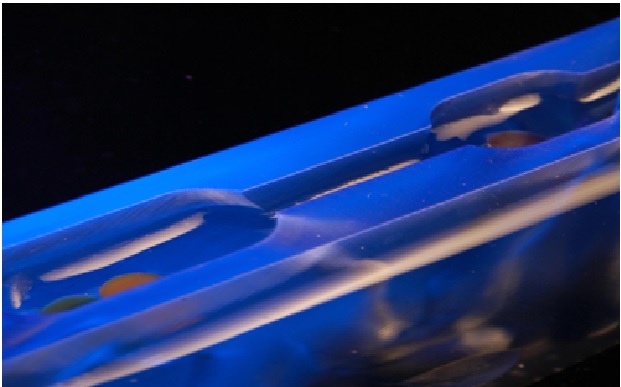Simple 3D-Printed Device May Pave the Way for Far More Powerful Cell Phones and WIFI
The next generation of phones and wireless devices will require new antennas to access ever higher frequency bands. One way to make antennas that operate at tens of gigahertz—the frequencies needed for 5G devices and beyond—is to weave filaments about 1 micrometer in diameter. However, modern industrial manufacturing methods do not work with fibers of this size.
Now a team of engineers and scientists at Harvard’s John A. Paulson School of Engineering and Applied Science (SEAS) has developed a simple machine that uses the surface tension of water to grasp and manipulate microscopic objects. This remarkable innovation offers a potentially powerful tool for nanoscopic fabrication. [1]

Figure 1. Simple 3D-Printed Device May Pave the Way for Far More Powerful Cell Phones and WIFI
Figure 1 shows the machine is a 3D-printed plastic rectangle that’s about the size of an old Nintendo cartridge. The interior of the device is carved with intersecting channels. Each channel has wide and narrow sections, similar to a river that expands in some parts and narrows in others. The channel walls are hydrophilic, meaning they attract water.
Through a series of simulations and experiments, scientists discovered that when they submerged the device in water and placed a millimeter-sized plastic float in the channel, the surface tension of the water caused the wall pushed back the float. If the float was in a narrow section of the channel, it moved to a wide section, where it could float as far away from the walls as possible. [2]
Next, the investigators demonstrated that the floats themselves could be microscopic. They constructed machines that could trap and move colloidal particles 10 micrometers in size — even though the machines were a thousand times bigger.
Next, the team aims to design devices that can simultaneously manipulate many fibers, with the goal of making high-frequency conductors. They also plan to design other machines for micromanufacturing applications, such as building materials for optical devices from microspheres. [3]
References:
- https://scitechdaily.com/simple-3d-printed-device-may-pave-the-way-for-far-more-powerful-cell-phones-and-wifi/
- https://douviral.com/cbmibmh0dhbzoi8vc2npdgvjagrhawx5lmnvbs9zaw1wbgutm2qtchjpbnrlzc1kzxzpy2utbwf5lxbhdmutdghllxdhes 1mb3itzmfylw1vcmutcg93zxjmdwwty2vsbc1wag9uzxmtyw5klxdpzmkv0gfyahr0chm6ly9zy2l0zwnozgfpbhkuy29tl3npbxbszs0z/
- https://scitechdaily.com/simple-3d-printed-device-may-pave-the-way-for-far-more-powerful-cell-phones-and-wifi/
Cite this article:
Thanusri swetha J (2022) Simple 3D-Printed Device May Pave the Way for Far More Powerful Cell Phones and WIFI, Anatechmaz, pp. 425

